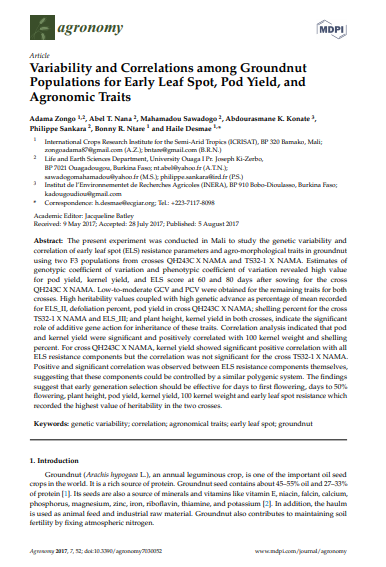Variability and Correlations among Groundnut Populations for Early Leaf Spot, Pod Yield, and Agronomic Traits
Summary
The present experiment was conducted in Mali to study the genetic variability and correlation of early leaf spot (ELS) resistance parameters and agro-morphological traits in groundnut using two F3 populations from crosses QH243C × NAMA and TS32-1 × NAMA. Estimates of the genotypic coefficient of variation and phenotypic coefficient of variation revealed high value for pod yield, kernel yield, and ELS score at 60 and 80 days after sowing for the cross QH243C × NAMA. Low-to-moderate GCV and PCV were obtained for the remaining traits for both crosses. High heritability values coupled with high genetic advance as a percentage of the mean recorded for ELS_II, defoliation percent, pod yield in cross QH243C × NAMA; shelling percent for the cross TS32-1 × NAMA and ELS_III; and plant height and kernel yield in both crosses indicate the significant role of additive gene action for inheritance of these traits. Correlation analysis indicated that pod and kernel yield were significant and positively correlated with 100 kernel weight and shelling percent. For cross QH243C × NAMA, kernel yield showed significant positive correlation with all ELS resistance components but the correlation was not significant for the cross TS32-1 × NAMA. Positive and significant correlation was observed between ELS resistance components themselves, suggesting that these components could be controlled by a similar polygenic system. The findings suggest that early generation selection should be effective for days to first flowering, days to 50% flowering, plant height, pod yield, kernel yield, 100 kernel weight, and early leaf spot resistance, which recorded the highest value of heritability in the two crosses.
Open resource Download resource Access resource on external site

